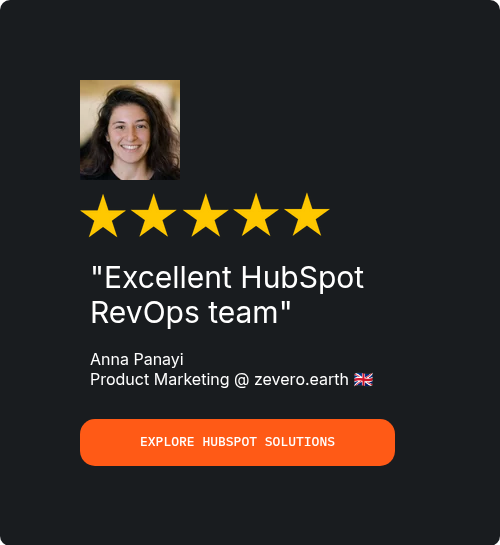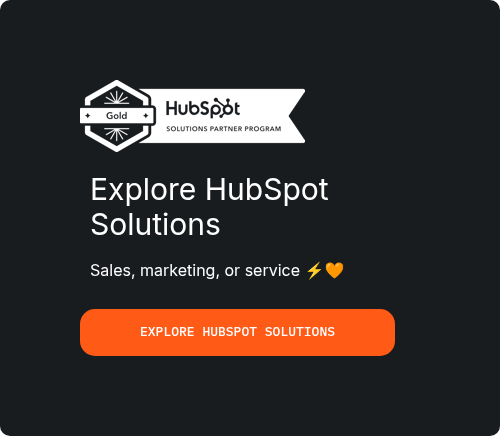There’s an old saying that “sometimes, the left hand doesn’t know what the right hand is doing.”
In the B2B marketing and sales world, that’s often called misalignment.
When your sales and marketing teams aren’t in sync, you get more than just a few crossed wires. You end up with wasted budgets, missed opportunities, and frustrated prospects who feel like they’re being handed off from one disconnected conversation to another.
The question is: how do you make “both hands” self-aware of what’s going on? In other words, if we were to talk about competition, operational efficiency, and such elements in the context of Hubspot for B2B marketing teams, there’s a lot that you could learn, despite the odd obstacles that show up every now and then.
This problem can be fixed, and one of the most effective tools, as we just mentioned a bit earlier, for doing it is HubSpot for B2B marketing. The platform gives you one shared space where sales and marketing can actually work together toward the same goals, see the same data, and measure success in the same way.
On that note, we’d say that this post isn’t your typical software features showcase, which would make sense, as most of the platforms rendering any or such services, like to talk about a particular software that they’re affiliated with.
While that’s also true in Pixcell’s case, we like to double down on exactly what’s going on behind the scenes when it comes to understanding different aspects of HubSpot. It’s more about empowering teams and fixing the way your business handles different activities - and that too, without banking on your revenue from a long term aspect.
So let’s walk through what sales and marketing alignment really means, why it matters for B2B companies, and how HubSpot’s B2B marketing features can make it a reality.
What Sales and Marketing Alignment Really Means in B2B
When we talk about aligning sales and marketing, we’re talking about more than having an occasional joint meeting. It’s about building a shared playbook — one where both teams:
- Agree on who your ideal customers are
- Speak the same language when it comes to leads and pipeline stages
- Share data instead of keeping it in separate silos
- Hold each other accountable to the same business goals
In practical terms, alignment means marketing is creating content, campaigns, and messaging that sales can actually use — and sales is providing feedback that marketing can act on to improve lead quality.
For B2B companies, this is even more important.
How so?
Given the ongoing pressure to scale business and convert more without burning through resources, a business’s sales cycles are longer, buying committees are larger, and decisions involve more research before a prospect even talks to your sales team.
That means the handoff from marketing to sales has to be flawless, or you risk losing the lead before they’re even halfway through the funnel.
Why Alignment Matters So Much for B2B Marketing Teams
B2B marketing and sales alignment is not just a “nice to have” — it’s a competitive advantage.
Companies that nail this see stronger growth, more predictable revenue, and happier customers. Here’s why:
Higher Revenue Potential
When sales and marketing are synced up, high-quality leads don’t slip through the cracks. Marketing spends less time chasing vanity metrics like clicks and more time delivering leads that sales can close.
Speaking of which, there are many industry studies that have shown that aligned teams can accelerate revenue growth significantly compared to those still operating in silos.
Better Customer Retention
In any business to business setting, the post-sale relationship matters just as much as the initial deal.
When sales pick up where marketing left off — with full context of the buyer’s journey — customers get a consistent experience that builds trust. Aligned companies often see retention rates rise substantially.
More Efficient Operations
Misalignment often means double work — the same research, data entry, or customer communication happening twice.
That being said, there’s a workaround to this issue.
As a manager, or someone in charge of the team level business operations, if you were toalign operations based on some sort of benchmark, or standards, you’d be easily able to eliminate those bottlenecks and free up time for everyone to focus on things that matter the most.
The Shared Goals and Metrics That Keep Teams on Track
In order for HubSpot B2B marketing to truly work, sales and marketing have to measure success using the same scoreboard. That means agreeing on what matters and tracking it consistently.
Before listing the common metrics, it’s worth noting why this is so critical: without shared goals, each team will optimize for different outcomes, which is a recipe for friction. Marketing might chase big lead volumes, while sales want fewer but better-qualified opportunities.
Here are the metrics that typically form the foundation of alignment:
- Revenue Targets – Both teams work toward the same revenue numbers, not separate ones. This often means shared quotas and joint accountability for deals closed from marketing-sourced leads.
- Lead Qualification Standards – Agreeing on what constitutes a Marketing Qualified Lead (MQL) versus a Sales Qualified Lead (SQL) ensures everyone’s talking about the same thing.
- Conversion Rates – Tracking how leads move from MQL to SQL to customer helps identify where drop-offs happen and what needs fixing.
- Customer Acquisition Cost (CAC) – A single, agreed-upon number for what it costs to win a new customer keeps marketing spend and sales effort in balance.
- Customer Lifetime Value (CLV) – A reminder that the best customers are often the ones who stay longer, not just the ones who close fastest.
How Misalignment Happens in the First Place?
Good question.
Normally, it doesn’t happen all at once. The entire “process” could take months before cracks start appearing. And this isn’t just about HubSpot.
We’ve seen and heard from tons of companies where, despite having a killer software solution, there are still issues with operations, team efficiency, business scalability, and of course, those conversions that we all look forward to.
Things just pile up when it comes to the misalignment factor.
Now, blend together lack of communication, a backlog that keeps increasing bit by bit, not paying attention to what the competitors are up to, not taking customer feedback into account, and sliding those dev side updates that people asked for, under the rug - so on and so forth.
It’s a combination of different errors, the usual procrastination factor at the team level, missed meetings, late implementation of stuff, and vice versa.
Just to give you an idea of how to spot these setbacks, here are a couple of pointers to highlight things for you:
Lack of Consistent Communication
When teams rarely talk, they start operating on assumptions. Sales might assume marketing isn’t sending quality leads, while marketing assumes sales just aren’t following up quickly enough.
Conflicting Priorities
Marketing is often tasked with increasing lead volume, while sales is focused on closing deals. Without a bridge between those objectives, frustration builds.
Siloed Data and Systems
Separate CRMs, spreadsheets, and analytics tools mean the two teams are looking at different versions of the truth. That makes collaboration nearly impossible.
Different Team Cultures
Marketing often thinks long-term — brand building, nurturing, awareness. Sales is usually short-term focused — this month’s quota, this quarter’s numbers. Without understanding each other’s timelines, both sides can misinterpret the other’s actions.
These aren’t just annoyances; they actively cost companies money.
The longer these issues go unresolved, the more revenue opportunities slip away.
How HubSpot Solves These B2B Marketing Pain Points
This is where HubSpot for B2B stands out. The platform was built with the idea that sales and marketing should work from the same system, not just swap reports now and then.
When you use HubSpot B2B marketing tools, you’re giving both teams:
- A centralized CRM where every lead’s history lives in one place.
- Marketing automation tools that feed directly into sales pipelines.
- Shared dashboards so there’s no debate about what’s happening with leads.
- Built-in lead scoring that both teams agree on.
Instead of marketing throwing leads over the wall, HubSpot lets you design a seamless journey — from the first website visit to the closed deal — inside one connected platform.
Key HubSpot Features That Drive B2B Sales & Marketing Alignment
To really understand why HubSpot works so well for B2B marketing teams, let’s walk through its most impactful features and how they solve day-to-day challenges.
1. Centralized CRM for Both Teams
HubSpot’s CRM isn’t just a place to store contact details. It tracks every interaction — email opens, website visits, form submissions — so both marketing and sales can see the full picture. No more blind follow-ups or guessing what a prospect knows.
2. The Marketing Hub for Campaign Management
The B2B marketing HubSpot environment includes everything from landing page builders to SEO tools. This means you can run campaigns, track performance, and see which efforts actually generate sales-ready leads.
3. Automation That Works in the Background
Workflows can handle lead nurturing, scoring, and assignment automatically. For example, if a prospect downloads a pricing guide, they can be instantly tagged as high intent and sent to sales for a quick follow-up.
4. Lifecycle Stages That Make Sense
Instead of generic stages, HubSpot lets you define stages that match your sales process — from Subscriber to MQL to SQL to Opportunity to Customer. Everyone uses the same definitions, which cuts down on confusion.
5. Reporting That Closes the Loop
With shared dashboards, you can connect marketing activity directly to revenue outcomes. That means proving which campaigns bring in real opportunities, not just traffic.
Automating B2B Lead Generation with HubSpot
Automation isn’t about replacing the human touch — it’s about making sure your teams spend more time having meaningful conversations and less time chasing down basic follow-ups.
With HubSpot, B2B marketers can set up workflows that:
- Send tailored follow-up emails based on a prospect’s last action.
- Score leads in real time so sales knows who to call first.
- Move contacts through lifecycle stages without manual updates.
- Trigger retargeting ads when a high-value lead visits your pricing page.
This means leads never sit idle. If a prospect shows buying signals at 9 AM, they can be in a salesperson’s queue by 9:01.
Proven B2B Lead Generation Strategies Inside HubSpot
HubSpot isn’t just a CRM — it’s a lead generation engine when used effectively. Here’s how B2B teams can get the most out of it:
Content Marketing + SEO That Targets Buyer Intent
HubSpot’s SEO tools help identify the keywords your buyers are actually searching for. From there, you can build topic clusters and publish blogs, guides, and whitepapers that position your company as the go-to resource.
Smart CTAs and Landing Pages That Convert
Instead of static calls-to-action, HubSpot lets you serve dynamic CTAs based on who’s visiting. Pair that with optimized landing pages and you turn more website visitors into leads.
Multi-Channel Campaign Management
You can coordinate email, social, and paid ad campaigns from within HubSpot. Segmenting your audience means the right people see the right message at the right time — and you can measure it all in one place.
Real-World Example: HubSpot for B2B in Action
Imagine a software company selling to mid-sized manufacturers.
Before HubSpot, marketing used one platform for email, another for social ads, and stored leads in spreadsheets. Sales had their own CRM that didn’t talk to marketing’s tools. Leads were getting lost.
After moving to HubSpot B2B marketing, the two teams share one CRM.
At this point, your marketing teams can see which ads generate the most sales calls, and sales can see all the content a lead engaged with before the first meeting. Lead follow-up time drops from days to minutes, and win rates go up.
Summing It Up
Sales and marketing alignment isn’t a one-time project — it’s an ongoing process.
But with the right toolset, it’s far easier to maintain. HubSpot for B2B gives you that single source of truth and the automation you need to keep both teams moving in the same direction.
It’s more of a ritualistic activity that needs to be improvised on, repeated, and updated from time to time. The phrase, “you need to be up on your toes” befits such businesses perfectly because there are one too many companies that had a good start, but eventually ran out of business - HubSpot or no HubSpot!
Frequently Asked Questions
1. Why do B2B marketing and sales teams struggle to work together effectively?
One of the biggest reasons is that each team often operates in its own “bubble.” Marketing might be focused on generating a high volume of leads through campaigns, SEO, and content, while sales is focused on closing deals as quickly as possible.
Without a common understanding of what a qualified lead looks like, marketing could end up sending prospects that sales sees as unready, while sales might deprioritize leads that marketing considers valuable.
Another issue is fragmented data. If marketing is using one set of tools to capture and track leads, and sales is using an entirely different CRM, there’s no shared visibility into the buyer’s journey. This creates delays, missed opportunities, and a lack of accountability.
HubSpot solves this by providing a shared CRM where both teams can see the same contact history, interactions, and engagement metrics in real time. That shared view makes it much easier to align strategies and reduce friction.
2. What are the most common challenges in managing B2B lead generation without a platform like HubSpot?
Without a centralized system like HubSpot B2B marketing, lead generation becomes a patchwork of disconnected tools, spreadsheets, and manual follow-ups.
For example, a marketing team might run a great ad campaign that drives form submissions — but if those leads aren’t automatically routed to sales with the right context, they can sit idle for days, reducing the chances of conversion.
Another challenge is scoring and prioritizing leads. In many organizations, this is done manually or not at all, which means sales reps may spend time calling prospects who aren’t anywhere near ready to buy. HubSpot’s automated lead scoring takes behavior and engagement into account, helping sales focus on prospects showing real intent.
And because the platform also manages marketing campaigns, landing pages, and workflows, it ensures that prospects are consistently nurtured until they’re ready for direct outreach.
3. How does HubSpot actually help improve ROI for B2B marketing teams?
ROI in B2B marketing depends on both the quality of leads generated and the efficiency of converting them.
HubSpot improves both by connecting every stage of the funnel in one place. When marketing creates a campaign, they can immediately track not just clicks or downloads, but which of those leads became opportunities and eventually closed deals. This eliminates the guesswork and allows teams to double down on campaigns that actually produce revenue.
From an efficiency standpoint, HubSpot reduces the manual workload that eats into ROI. Automated workflows ensure that no lead is forgotten, while shared dashboards help both sales and marketing understand exactly where each lead stands.
This also makes budgeting more strategic — instead of spreading resources across unproven channels, teams can invest in the tactics HubSpot’s reporting shows are most profitable.
Over time, that kind of data-driven decision-making significantly increases marketing’s contribution to overall company growth.
Tags:
hubspot for b2b teams



